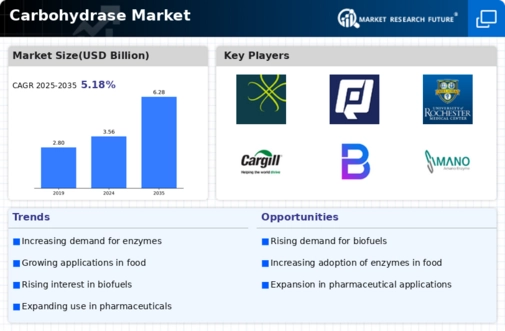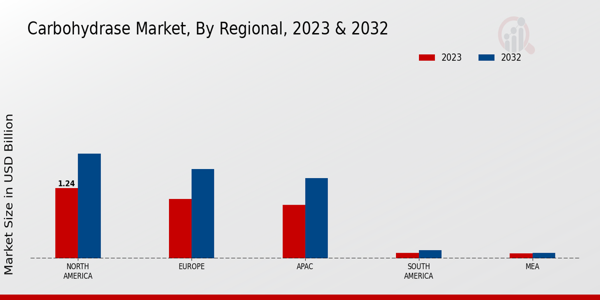Market Trends and Projections
The Global Carbohydrase Market Industry is characterized by dynamic trends and projections that indicate robust growth. With a market value of 3.56 USD Billion in 2024, the industry is expected to expand significantly, reaching 6.28 USD Billion by 2035. The compound annual growth rate of 5.3% from 2025 to 2035 reflects the increasing adoption of carbohydrases across various sectors, including food and beverage, biofuels, and pharmaceuticals. These trends highlight the industry's potential and the growing recognition of the vital role that carbohydrases play in enhancing product quality and sustainability.
Expansion of Biofuel Production
The Global Carbohydrase Market Industry is significantly influenced by the expansion of biofuel production, which relies heavily on carbohydrate conversion. As countries strive to reduce carbon emissions and transition to renewable energy sources, the demand for enzymes that facilitate the breakdown of starches and sugars into fermentable sugars is likely to increase. This trend aligns with global sustainability goals and presents a lucrative opportunity for the carbohydrase market. The industry could see a substantial increase in revenue, potentially reaching 6.28 USD Billion by 2035, as biofuel production continues to gain momentum.
Rising Demand for Processed Foods
The Global Carbohydrase Market Industry experiences a notable surge in demand for processed foods, driven by changing consumer lifestyles and preferences. As more individuals seek convenience, the need for enzymes that enhance food texture and flavor becomes paramount. Carbohydrases play a crucial role in the production of various processed foods, including baked goods and beverages. This trend is expected to contribute to the market's growth, with projections indicating a market value of 3.56 USD Billion in 2024. The increasing consumption of ready-to-eat meals and snacks further underscores the importance of carbohydrases in food manufacturing.
Growing Awareness of Health Benefits
The Global Carbohydrase Market Industry is witnessing a shift towards healthier food options, driven by growing consumer awareness of health benefits associated with enzyme supplementation. Carbohydrases are recognized for their role in improving digestion and nutrient absorption, which aligns with the rising demand for functional foods. As consumers become more health-conscious, the incorporation of carbohydrases in dietary supplements and health foods is likely to increase. This trend not only supports market growth but also encourages innovation in enzyme formulations to cater to diverse dietary needs, thereby expanding the market's reach.
Regulatory Support for Enzyme Applications
Regulatory support for enzyme applications is a crucial driver for the Global Carbohydrase Market Industry. Governments worldwide are increasingly recognizing the benefits of enzymes in various sectors, including food, agriculture, and biofuels. This support often translates into favorable regulations that promote the use of carbohydrases, facilitating their integration into industrial processes. As regulatory frameworks evolve to accommodate innovative enzyme applications, the market is poised for growth. The alignment of regulatory policies with industry needs may further enhance the adoption of carbohydrases, contributing to the overall expansion of the market.
Technological Advancements in Enzyme Production
Technological advancements in enzyme production are reshaping the Global Carbohydrase Market Industry. Innovations in fermentation technology and genetic engineering have led to the development of more efficient and cost-effective carbohydrases. These advancements not only enhance enzyme activity but also improve stability and specificity, making them more suitable for various industrial applications. As a result, manufacturers are increasingly adopting these advanced enzymes to optimize production processes. This trend is expected to drive market growth, with a projected compound annual growth rate of 5.3% from 2025 to 2035, reflecting the industry's adaptability to evolving technological landscapes.




















